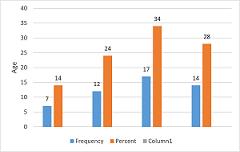Cancer Screening Technology and Attitude of Women Towards Cervical Cancer

Abstract:
Cervical cancer claims over a quarter
of a million lives of women annually worldwide. It is believed to be the second
most common cancer among women worldwide. Screening is used to detect precancerous
changes or early cancers before signs or symptoms of cancer occur. The first case
of cervical cancer was founded in the 1970s by Harald Zur Hausen. It is believed
to be the second most common cancer among women worldwide. Females becoming sexually
active in early age with multiple partners are on high risk. Virtually all cervical
cancers are associated with human papilloma viruses (HPV). This study was conducted
to understand the levels of knowledge and attitudes of women towards cervical cancer
screening in Al Khan Dubai.It assessed the knowledge and attitudes of women about
cervical cancer prevention. 70% of the sexually active women really need to go for
cancer screening. It shows that 66% of women in al khan are being affected due to
lifestyle and it is affecting women’s decision in relation to cervical cancer screening.
To improve cervical cancer screening in al khan area, women should be given more
information, motivation, awareness, and sensitization, in order to encourage them
to go for a cervical cancer screening.
References:
[1] American
Cancer Society. Cervical Cancer. Atlanta, GA: American Cancer Society; 2006. [19
April 2011]. Accessed at http://www.cancer.org/cancer/cervicalcancer/index.
[2] Kinney, W., Sung, H. Y.,
Kearney, K. A., Miller, M., Sawaya, G., & Hiatt, R. A. (1998). Missed opportunities
for cervical cancer screening of HMO members developing invasive cervical cancer
(ICC). Gynecologic oncology, 71(3), 428-430.
[3] Schiffman
M, Wentzensen N, Wacholder S, et al. Human papillomavirus testing in the prevention
of cervical cancer. J Natl Cancer Inst. 2011; 103:368–383.
[4] Robert Koch-Institut; Gesellschaft
der epidemiologischen Krebsregister in Deutschland e.V., Hrsg. Berlin: 2012. Krebs
in Deutschland 2007/2008. 8. Ausgabe.
[5] Chang AR.
Carcinoma in situ of the cervix and its malignant potential: a lesson from New Zealand.
Cytopathology. 1990; 1:321–328.
[6] Kinlen LJ,
Spriggs AI. Women with positive cervical smears but without surgical intervention:
a follow-up study. Lancet. 1978; 2:463–465.
[7] Chang AR.
Carcinoma in situ of the cervix and its malignant potential: a lesson from New Zealand.
Cytopathology. 1990; 1:321–328.
[8] WHO regional office for Europe,
available on https://www.euro.who.int/en/health-topics/noncommunicable-diseases/cancer/news/news/2012/2/early-detection-of-common-cancers/cervical-cancer#:%7E:text=Cancer%20of%20the%20cervix%20uteri,programmes%20have%20a%20long%20history. Trottier
H, Franco EL. The epidemiology of genital human papillomavirus infection. Vaccine.
2006;24(Suppl 1): S1–S15.
[9] Saraiya
M, Ahmed F, Krishnan S, et al. Cervical cancer incidence in a pre-vaccine era in
the United States, 1998–2002. Obstet Gynecol. 2007; 109:360–370.
[10] Schiffman, M., Wentzensen,
N., Wacholder, S., Kinney, W., Gage, J. C., & Castle, P. E. (2011). Human papillomavirus
testing in the prevention of cervical cancer. Journal of the National Cancer
Institute, 103(5), 368-383.
[11] Vu, M., Yu, J., Awolude,
O. A., & Chuang, L. (2018). Cervical cancer worldwide. Current problems in
cancer, 42(5), 457-465.
[12] Gravitt, P. E., Coutlée,
F., Iftner, T., Sellors, J. W., Quint, W. G., & Wheeler, C. M. (2008). New technologies
in cervical cancer screening. Vaccine, 26, K42-K52.
[13] Cuzick J,
Arbyn M, Sankaranarayanan R, Tsu V, Ronco G, Mayrand MH, et al. Overview of Human
Papillomavirus-based and Other Novel Options for Cervical Cancer Screening in Developed
and Developing Countries. Vaccine 2008;26(Suppl 10): K29–41.
[14] Stoler MH,
Castle PE, Solomon D, Schiffman M. The expanded use of HPV testing in gynecologic
practice per ASCCP-guided management requires the use of well-validated assays.
Am J Clin Pathol 2007;127(3):335–7.
[15] Mupepi, S. C., Sampselle,
C. M., & Johnson, T. R. (2011). Knowledge, attitudes, and demographic factors
influencing cervical cancer screening behavior of Zimbabwean women. Journal of
Women’s Health, 20(6), 943-952.
[16] Wentzensen, N., & von
Knebel Doeberitz, M. (2007). Biomarkers in cervical cancer screening. Disease markers,
23(4), 315-330.
[17] Waggoner, S. E. (2003). Cervical
cancer. The Lancet, 361(9376), 2217-2225.
[18] Greer, B. E., Koh, W. J.,
Abu-Rustum, N. R., Apte, S. M., Campos, S. M., Chan, J., ... & Valea, F. A.
(2010). Cervical cancer. Journal of the National Comprehensive Cancer Network,
8(12), 1388-1416.
[19] Moore, D. H. (2006). Cervical
Cancer. Obstetrics & Gynecology, 107(5), 1152–1161.
[20] Eddy, D. M. (1990). Screening
for cervical cancer. Annals of Internal Medicine, 113(3), 214-226.
[21] Denny L, Kuhn L, Pollack
A, Wright Jr TC. Direct visual inspection for cervical cancer screening: an analysis
of factors influencing test performance. Cancer 2002 Mar 15;94(6):1699–707.
[22] Brown, J., Byers, T., Thompson,
K., Eldridge, B., Doyle, C., & Williams, A. M. (2001). Nutrition during and
after cancer treatment: A guide* for informed choices by cancer survivors. CA:
A Cancer Journal for Clinicians, 51(3), 153-181.
[23] Garlick PJ, McNurlan MA.
Protein metabolism in cancer patients. Biochimie 1994; 76:713- 717.
[24] Ottery F. Supportive nutritional
management of the patient with pancreatic cancer. Oncology 1996;10(Suppl):26-32.
[25] Franco, Eduardo L. DrPHa; Schlecht, Nicolas F. PhDb; Saslow, Debbie PhDc the Epidemiology of Cervical
Cancer, The Cancer Journal: September 2003 - Volume 9 - Issue 5 - p 348-359.

